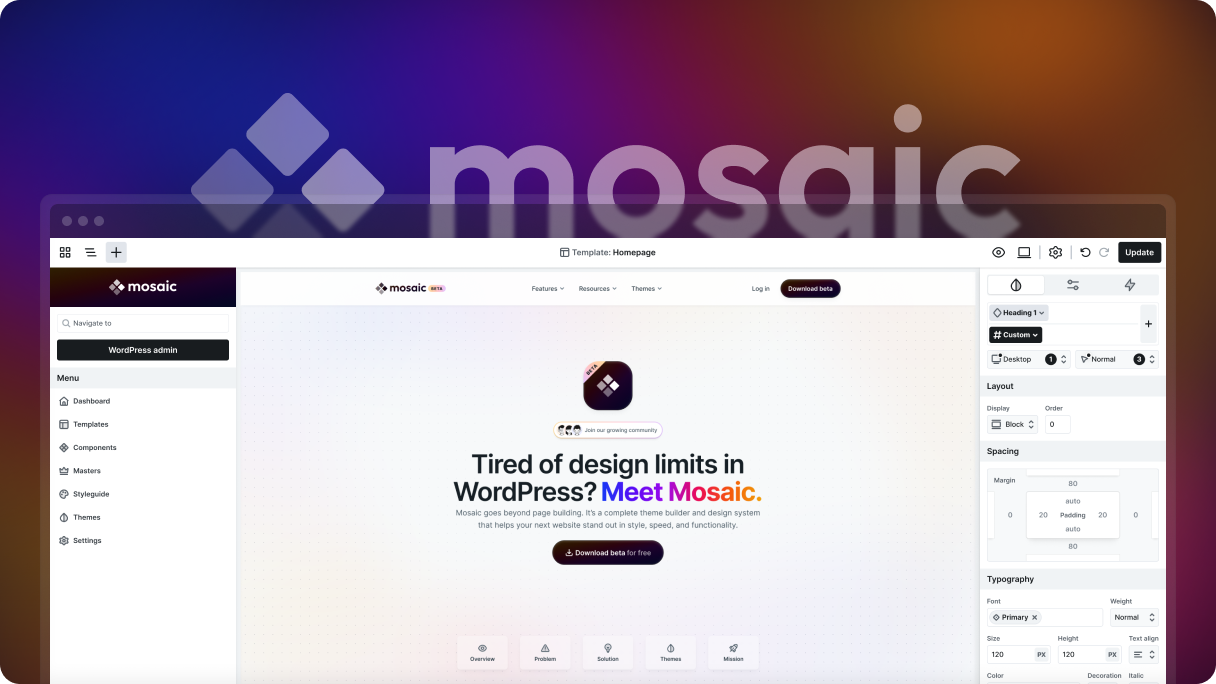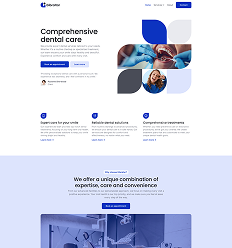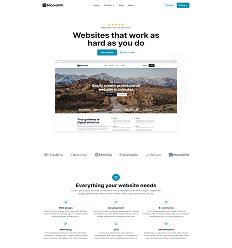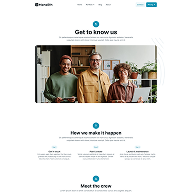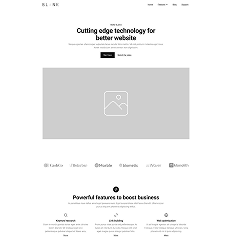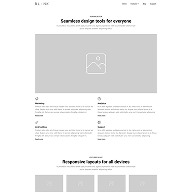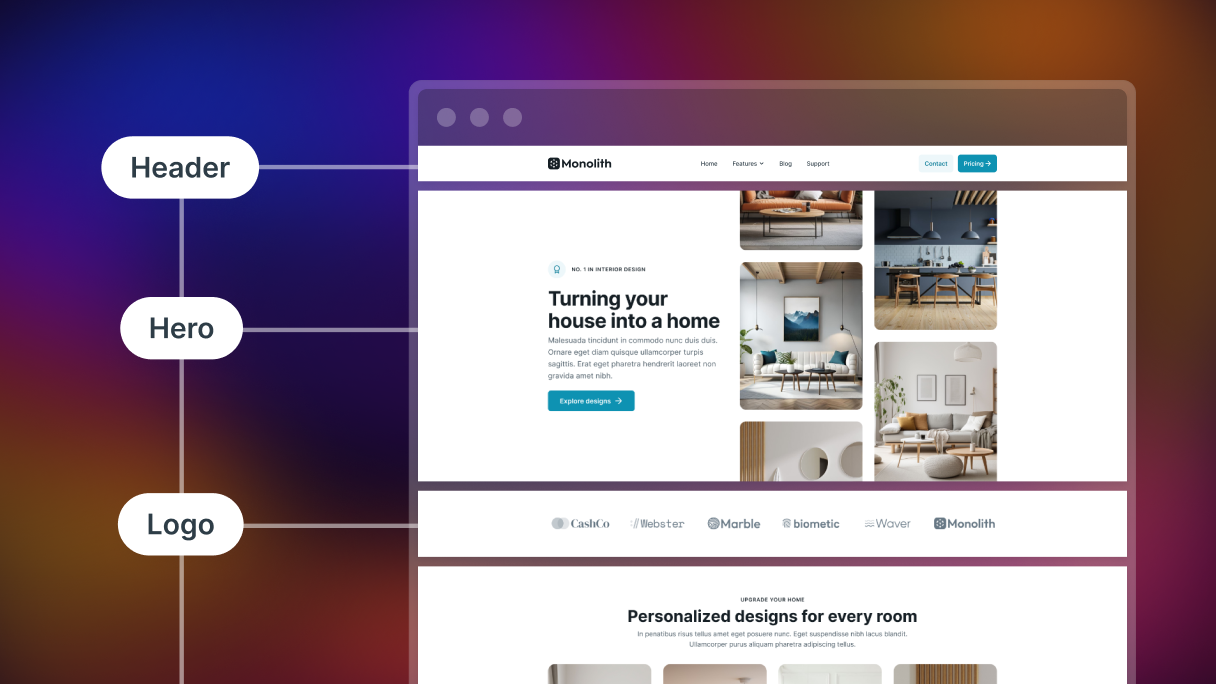Theme builder philosophy
In Mosaic, you don’t install a theme, you build a system. One that grows from your structure, your style, your decisions. It’s about building the foundation for every future page.
Most WordPress setups suffer from a core flaw: the theme and the builder aren’t made to work together. Mosaic fixes that by making them part of the same system. From the very first click, your theme and your builder speak the same language.
Instead of shaping your content around someone else’s layout, Mosaic invites you to do the opposite. Start from your own logic. Your theme doesn’t limit your thinking, it reflects it. That’s the foundation of Mosaic’s Theme Builder philosophy. Whether you start from scratch or use a prebuilt framework, everything you build is yours, scalable, structured, and consistent.
Let’s start where it all begins, with the Themes, where your Mosaic journey kicks off.
Themes: more than one starting point
In Mosaic, all themes include a full design system: style guide, pages, blocks, parts, and CSS class system. It gives you structure, not restrictions. Themes aren’t meant to box you in, they give you a smart starting point to build from.
Currently, Mosaic includes four distinct themes. Two are full-featured frameworks, prebuilt systems ready to go out of the box. The other two are made for full customization or wireframing, ideal when you want to build from zero. All themes are included in the core system, and the library continues to grow.
Every theme is modular and extendable, packed with over 400 unique blocks, 50+ prebuilt pages, and industry-specific page kits like Logistics or Architecture. These kits aren’t just fast to launch, they’re learning tools, showcasing real-world structure, reusable logic, and design clarity.
You also get a complete CSS class system tailored to all themes, with structural, utility, and style classes that make customization faster and more predictable. It’s a consistent foundation that makes edits cleaner, systems more scalable, and logic easier to extend.
So what do these themes actually look like in practice? Let’s walk through the four included in Mosaic today.
Empty
Empty is the purest possible starting point. It comes with no layout rules, no prebuilt styles, and no design logic, just bare elements and the minimum defaults needed to start rendering HTML. It’s not a theme in the traditional sense, it’s an advanced workflow tool for developers who want to define everything themselves.

If you want to build a design system from absolute zero, Empty gives you the silence to do it. No assumptions, no distractions, just full creative control.
Blank
Blank is all about freedom. It’s a light, unopinionated starting point that gives you just enough structure to begin, and then gets out of your way. Its wireframe-style layout and minimal styling make it perfect for prototyping, experimenting, or building your own system from scratch.
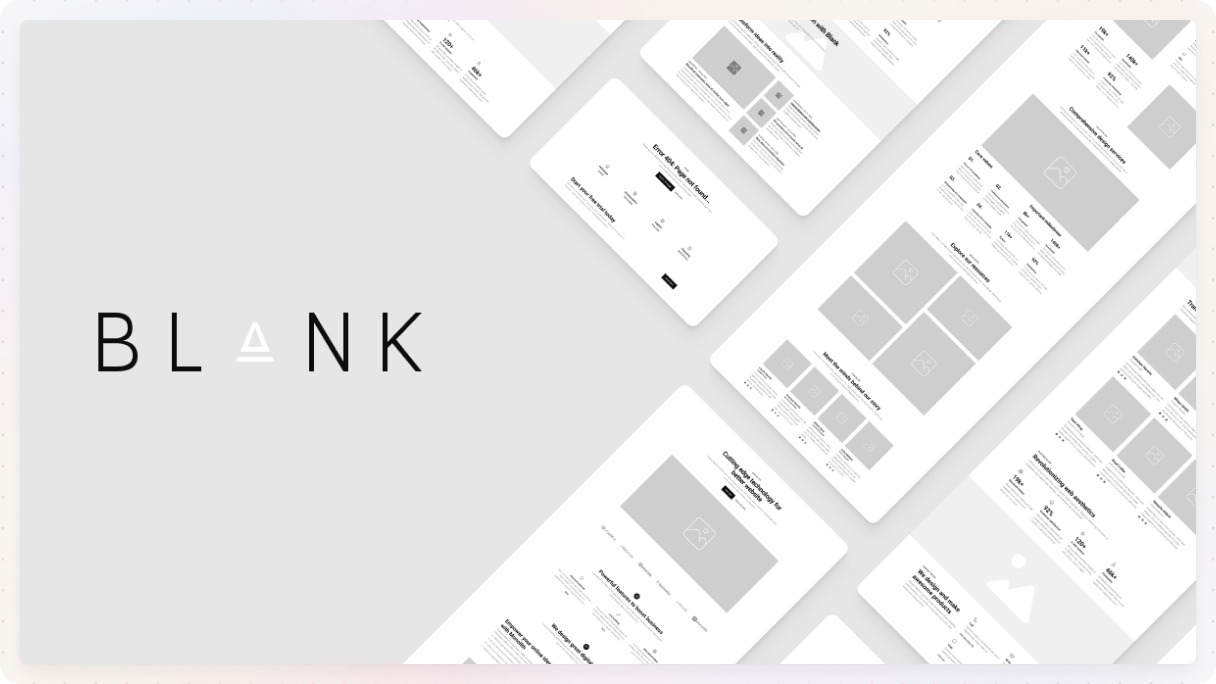
Even Blank includes a class system, because minimal doesn’t mean empty. With layout utilities, structure helpers, and base styles, it’s optimized for rapid styling and flexible development. Ideal for designers who want speed, structure, and total control.
Gibraltar
Gibraltar brings confidence and character to any project. Its design is expressive, modern, and full of energy, using vibrant accents, oversized shapes, and layered visual effects to create real presence. Typography is bold and contemporary, with crisp layouts that balance impact and clarity. The overall feel is energetic but accessible, designed to stand out without overwhelming.
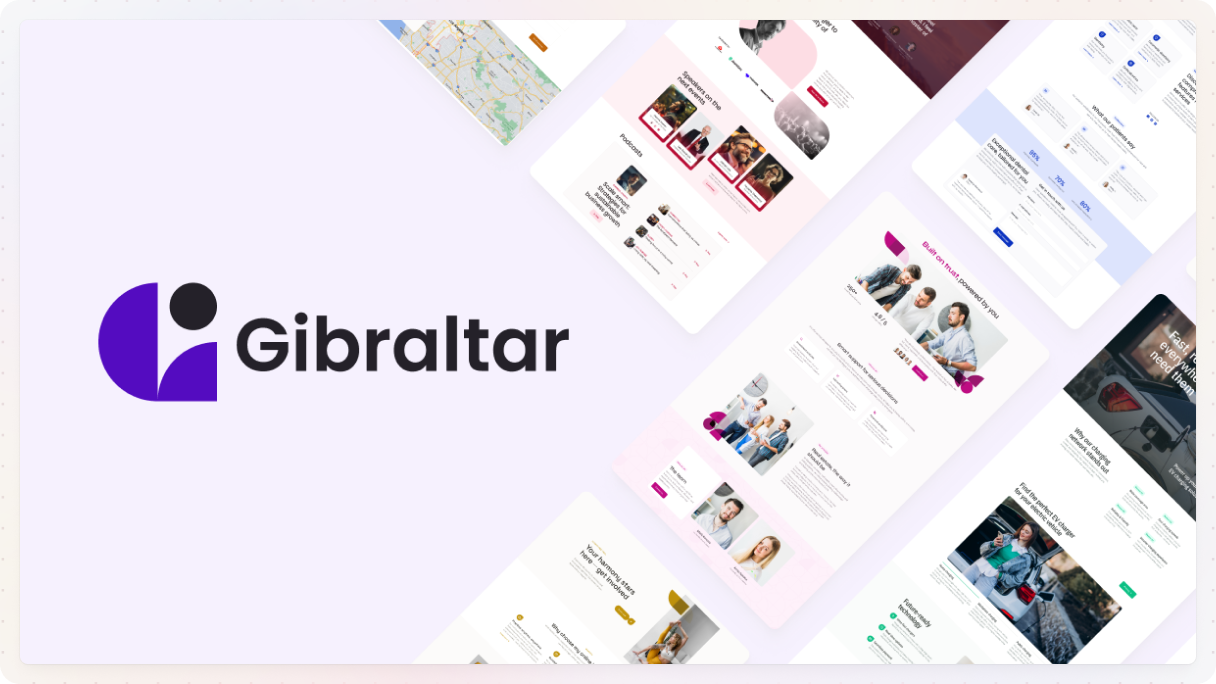
Like all Mosaic themes, Gibraltar comes with a complete CSS class system: layout helpers, utility classes, and style definitions. It’s a flexible, multipurpose system, expressive by default, extensible by design.
Monolith
Monolith finds clarity in simplicity. It uses minimal design with maximum clarity: spacious layouts, soft background details, and a visual calm that lets your content breathe. Typography is bold where it counts and clean where it guides. The result is a timeless, approachable atmosphere, bold in tone, gentle in detail, and adaptable to almost anything you build.
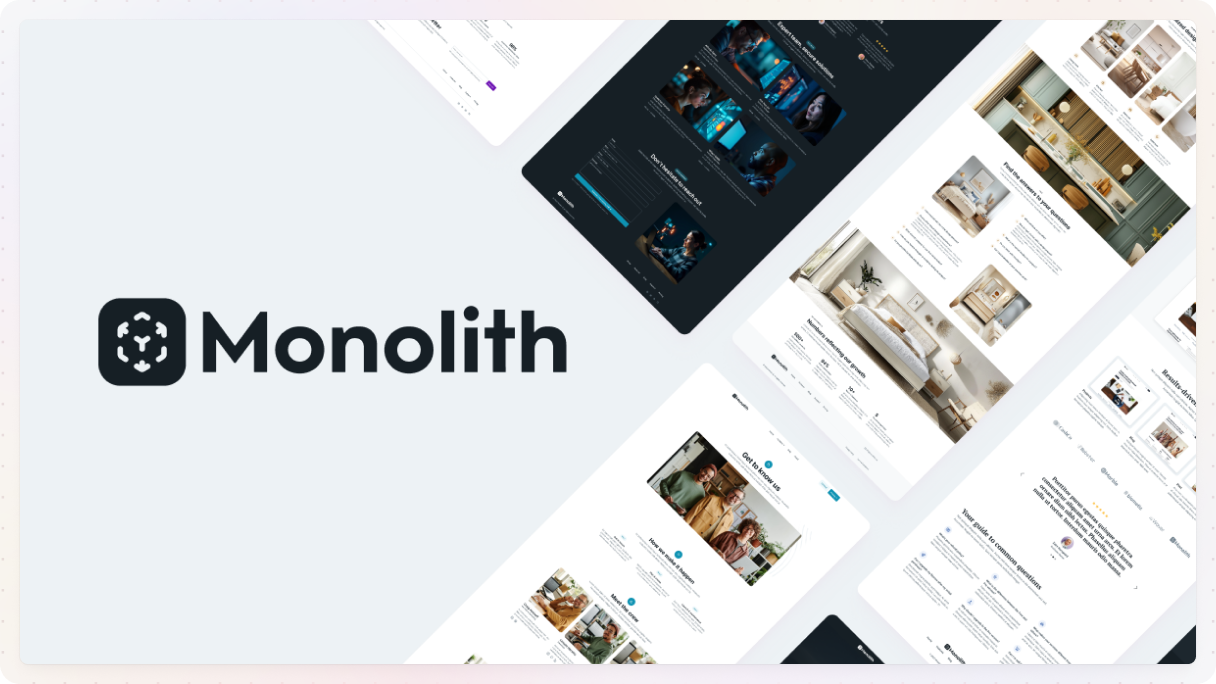
Monolith is a true multipurpose theme, equipped with a complete CSS class system, including structural, utility, and stylistic classes.
Once your base theme is in place, it’s time to define how your site behaves. That starts with the Wizard.
Wizard: your theme’s first steps
The Wizard isn’t just a setup, it’s where Mosaic starts thinking like you do. From layout choices to visual identity, this is where your system begins to take shape. Instead of forcing you into a rigid structure, it guides you through logical decisions that shape your theme from the inside out.
You start by choosing a theme, not as a fixed design, but as a flexible framework. Each one comes with its own structure, visual defaults, and logic-ready components. But it’s what you do next that turns it into your system.
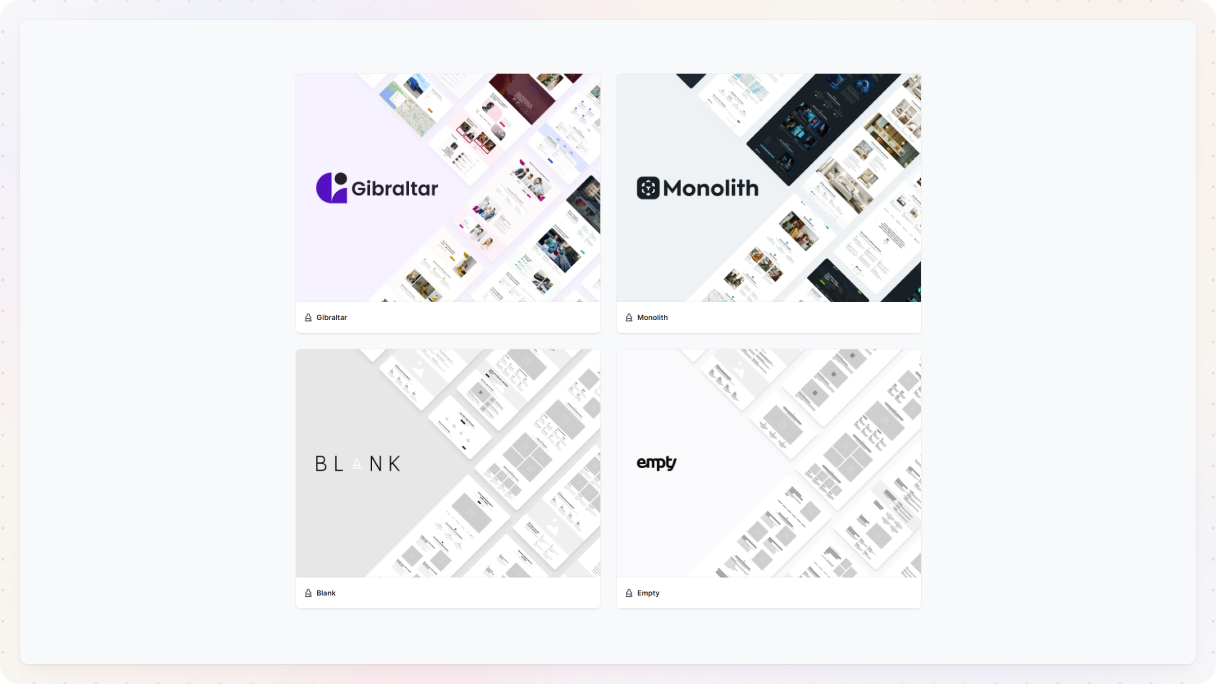
Define your visual language: pick a font pairing that fits your tone, choose a color skin that matches your brand, and set your preferred color mode, light, dark, or auto. These decisions don’t just style your site, they lay the groundwork for a consistent, scalable design system.
Then, choose your structure. Select a homepage, blog, and any additional pages you might need, like About, Contact, or Pricing. These aren’t filler templates or demo layouts. They’re modular, editable page structures that give you a functional starting point with room to grow.
By the time you finish the Wizard, you haven’t just clicked through setup, you’ve made foundational decisions about how your system looks, feels, and functions. What you get isn’t a website. It’s a tailored framework, structured to your logic and ready to expand with Masters, Templates, and everything else Mosaic offers.
Masters: where structure begins
If your theme is a system, the Master is its backbone. It defines the global structure your pages rely on, the navigation, the header, the footer that every visitor sees again and again.
Each template in Mosaic inherits its layout from a Master. That means you can build once and reuse everywhere, and when the structure changes, it updates across your site in an instant. Add a sticky header to your Master, and it’s applied across your Blog, your About page, your Contact page, no duplicates, no patchwork. Each theme can include multiple Masters, giving you full flexibility to define different page types with consistent logic.
But how do you turn a shared layout into real pages? That’s where Templates come in.
Templates: layout logic made visual
In Mosaic, templates define how a page looks, when it appears, and what dynamic content it should display. Every template starts by inheriting a Master: the global structure that frames your site. From there, the template defines the unique layout of a given page, what shows up, where it goes, and how it adapts to different devices or content types.
Templates can respond to anything. A blog post template loads content, title, author, and related posts. A member-only template can render entirely different layouts for logged-in and logged-out users. With conditions, fallbacks, and custom assignments, each template becomes a rule-based controller for its part of the site.
Each template also comes with a type, and that type defines its variable context. A “post” template unlocks post-related variables. This context-aware structure is what makes Mosaic dynamic: templates don’t just display content, they understand it.
From the Templates dashboard, you can manage all of this visually. Reorder priorities, assign templates to page types, preview their layout, or create fallbacks in case conditions aren’t met. It’s not just templating, it’s structured logic made visual.
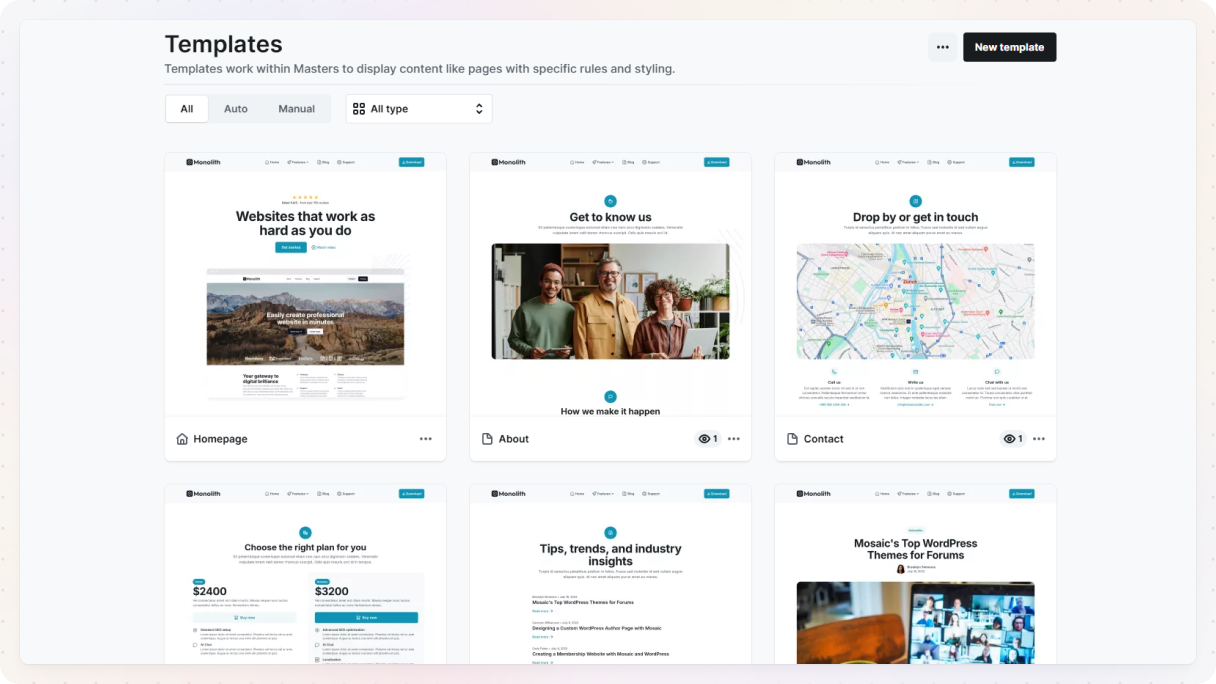
That’s how Mosaic themes are made, from blank canvas to scalable system. And it’s only the beginning.
Built to grow: what comes next
This is how Mosaic themes are made, not just to launch websites, but to create reusable systems. Every block, every layout, every rule you define becomes part of something bigger: your design logic.
Because in Mosaic, you don’t install a theme. You build one.
Next up, we explore the Editor, where you bring your system to life. From reusable Components to powerful Interactions, this is where structure meets expression.
